Male Reproductive System
It is formed of penis, testicles, prostate and seminal vesicles.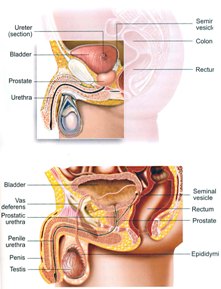
Video of Male Reproductive System
A-Testicle:
It is the site where sperms are formed. And it secrets male hormones (testosterone), sperms are present in small tubules called seminiferous tubules, that are coiled together, these tubules unite to form larger ones that eventually unite to form one duct called epididymis, which is coiled also if we assumed that we open it, its length may reach 6 meters, sperms pass through the epididymis by the time it reaches its end they are mature and are capable of motility and fertilization.
After the epididymis; it is connected to a thick tube that can be palpable in most men, it is called vas deference, it’s a transporting duct, that connect epididymis to the seminal vesicles (which has a role in semen production).
After seminal vesicles there is the ejaculatory duct which passes through prostate gland and opens in the urethra.
Spermatogenesis
1) Spermatogonial Phase (Mitosis): spermatogonia proliferate by mitotic divisions to provide stem cells and cells which will proceed through spermatogenesis (1º spermatocytes)
2) Spermatocyte Phase (Meiosis): 1º spermatocytes enter Meiosis I (reduction division) to form 2ry spermatocytes (diploid cells (2n) give rise to haploid cells (1n) ) which then enter Meiosis II (equatorial division) and result in spermatids
3) Spermatid Phase (Spermiogenesis): spermatid differentiation into spermatozoa
Function of Sertoli cells
1)They prevent the antibody producing cells in Extra cellular fluid from reaching the tubular sperm factory, thus preventing the formation of antibodies against the highly differentiated spermatozoa.
2) They provide a mechanical support for seminiferous tubules.
3) They provide nutrition for the developing sperm
4) Sertoli cells have an important phagocytic function. They destroy defective germ cells that fail to successfully complete all stages of spermatogenesis.
5) Sertoli cells secrete fluid into the seminferous tubule which pushes and flushes the release of sperm from tubule into the epididymis for storage.
6)Sertoli cells secrete a protein that binds testosterone thus maintaining a very high level of this hormone which is essential for spermatogenesis.
7)Sertoli cells secrete inhibin to regulate FSH secretion. Also Mullerian inhibitory factor during fetal life to inhibit the formation of Fallopian tube from Mullerian duct.
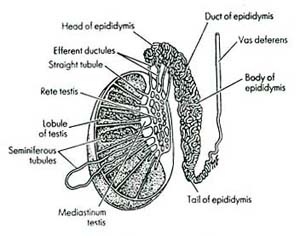
B-Penis:
It is formed of a sponge like body that is responsible for erection, inside the penis there is a duct called urinary duct both sperms and urine pass through this duct.
Pituitary hormones (LH and FSH) are secreted in men and women; their secretion is under the control of GNRH hormone secretion (a hormone that is secreted from the hypothalamus gland).
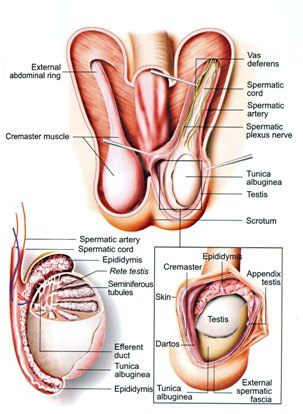
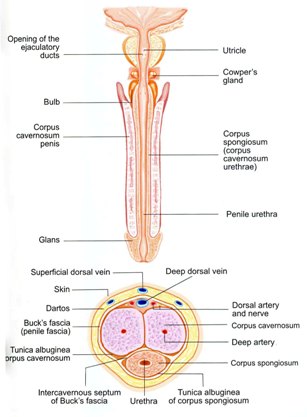
Male genital Organs
In men FSH hormone has a role in stimulating seminiferous tubules to produce sperms.
LH hormone stimulate certain cells in the testis (leydig cells) to produce testosterone hormone in the male, this hormone has a role in sperm production in addition to its role in secondary sexual characteristic of the male.
Dear readers: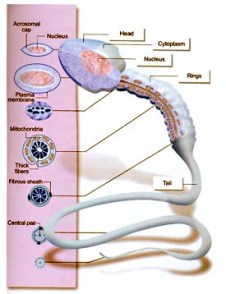
There are many questions that cross your minds and we are glade to answer what we think that is important for you.
-What does a sperm look like?
It is formed from head that contains the genetic material, and the middle part which is called (neck) that gives the energy needed for the sperm motility, the last part is the tail which helps the sperm to move forward inside the female genital tract, it should be noted here that the male starts sperm production only after puberty, unlike the female who is born with her ovaries already containing the follicles.
-How much time is needed for sperm production?
It takes around 60 days for production of sperms and 10-14 days to pass through the epididymis and vas deference.
-What is the amount of semen during ejaculation?
It is from 1-6 ml. At the time of ejaculation it is viscous but inside the female vagina it becomes less viscous (liquid) and that takes 20-30 minutes, the sperm needs 2 minutes to be able to pass through cervical mucus.
-How much sperms are produced during intercourse?
Around 100-300 million. A large number of sperms but only one sperm fertilize the oocyte, that is due to the large number of sperms that die during their passage in the female genital tract, beside that most of the semen comes out from the vagina, and only 1000 sperm reaches the oocyte, some may get through the outer membrane of the oocyte, but at the end only one sperm fertilize it.
-How long does the sperm live inside the female genital tract?
The definite answer is difficult, but sperms can be noticed in the vagina 16 hours after coitus and once it passes through the cervix, uterus and tube it can stay up to 3-4 days.
-Does abstinence improves sperm count? 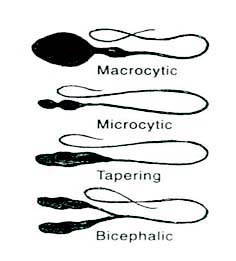
In abstinence, sperms don’t live forever, with time it loses its ability to fertilize, also in cases of abstinence the large number of sperms present will result in increase the number of old sperms, in this case though large number of sperms, but bad quality; so abstinence doesn’t improve fertility.
Video of Male Reproductive System
-Does being ill affects sperm count?
Any illness whatever it was simple, even tonsillitis may lead to decrease sperm count, and as said before 7-74 days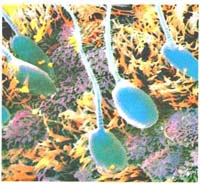 are needed to produce sperms any illness will affect production, so it is wrong to judge on the semen to be abnormal from one seminal fluid analysis, and it should be repeated several times (2-3 times) in months to make sure that it is abnormal, and treat accordingly.
are needed to produce sperms any illness will affect production, so it is wrong to judge on the semen to be abnormal from one seminal fluid analysis, and it should be repeated several times (2-3 times) in months to make sure that it is abnormal, and treat accordingly.
-Does smoking and alcohol affect male fertility?
Smoking leads to low sperm count and decrease motility, excess alcohol intake also leads to decrease sperm production indirectly by affecting male hormones and male sexual ability (impotence).
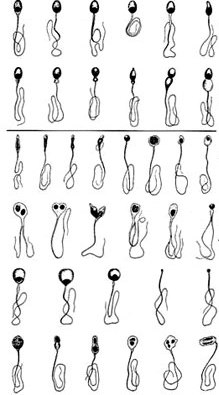
Normal and Abnormal Sperm
-Does taking certain medications affect sperm count?
There are some medications that does, and it has to be stopped and other alternatives with the same medical effect used; that doesn’t affect sperms, all this should be decided by the treating physician, some medications that lead to addiction like morphine may affect fertility.
-Can the woman get pregnant in any time of her cycle?
Usually conception happens at the time of ovulation, which is usually the middle of the cycle, ovulation may happen in a different time, but this is the exception not the rule.
-Does frequent intercourse decrease the rate of pregnancy?
Not necessarily, the most important thing that is when the women are trying to get pregnant, it is advised to have regular intercourse every 2-3 days at the time of ovulation.
-Does the feeling that most of the semen is coming out of the vagina during intercourse decrease pregnancy rate?
No, because once the semen is liquefied, sperms are able to pass through the cervix.
-Does pregnancy always happen when there is proper time of intercourse?
No, because the chance to get pregnant in healthy couples with the right time of intercourse is only 15-25% during each cycle.
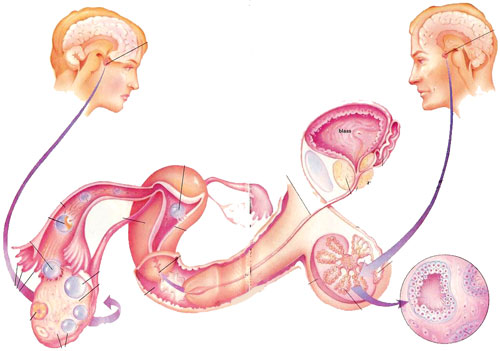
Dr Najeeb Layyous F.R.C.O.G
Consultant Obstetrician, Gynecologist and Infertility Specialist







 Pregnancy Due Date Calculator
Pregnancy Due Date Calculator
 Chinese Gender Predictor
Chinese Gender Predictor
 Ovulation Calculator
Ovulation Calculator
 IVF Due Date Calculator
IVF Due Date Calculator
